- Home
- Terry Pratchett
The Folklore of Discworld Page 19
The Folklore of Discworld Read online
Page 19
Morris Dancing, Light and Dark
There are some things Nanny Ogg took good care not to mention to the lady folklorist from the city – the things she calls the ‘real stuff’, things like the Dark Morris. The lady would be bound to get them all wrong anyway.
Now, even ordinary Morris dancing, what we may for convenience call the Light Morris, is a curious thing, both on Earth and on the Disc. A typical dance involves six men in two lines of three, facing each other; they are all dressed alike, usually in white, with coloured baldrics and decorated hats, and possibly with ribbons and rosettes too; they clash sticks in time to the music, miraculously avoiding one another’s fingers by a hair’s breadth, or wave large handkerchiefs, or clap; they have bells strapped to their ankles and knees. There will be one or two reserve dancers in the team, to replace anyone who retires exhausted or injured; a musician playing an accordion, or a fiddle, or in earlier centuries a pipe and tabor; a Fool; and someone to go round taking the collection.
On one level it’s a public display of skill, strength, stamina and sheer bloody-mindedness, which some people in Lancre think of as entertainment and others as a form of martial art (especially when sticks and buckets are involved). There is a definite competitive edge to it. You can have events like the Fifteen Mountains All-Comers’ Championships, which the Lancre Morris Men have won no fewer than six times. It gives the teams a chance to dress up and swagger around, to be someone special.
In Elizabethan England, the strict Puritans thought the swaggering was much too much fun, both for the dancers and the crowd. In 1583 Philip Stubbes complained furiously in his Anatomie of Abuses that at village festivals there would be Morris Men dressed in ‘green, yellow, or some other light wanton colour’:
And as though that were not gaudy enough, I should say, they bedeck themselves with scarfs, ribbons and laces, hanged all over with gold rings, precious stones and other jewels; this done, they tie about either leg twenty or forty bells, with rich handkerchiefs in their hands, and sometimes laid across their shoulders and necks, borrowed for the most part from their pretty Mopsies or loving Betties, for bussing them in the dark … Then march this heathen company towards the church and churchyard, their pipers piping, their drummers thundering, their stumps dancing, their bells jingling, their handkerchiefs fluttering above their heads like mad men, their hobby horses skirmishing among the throng.
On a second level – at any rate in England, where it has flourished (off and on) for at least six hundred years – Morris dancing used to be an excellent way for working men in country districts to get free beer and food and some extra cash. They would appear at seasonal festivals such as May Day and Whitsun, and also at whichever date the local fair was held; in winter they would go round performing outside the houses of the wealthy. This was a great asset when times were hard, as they so often were in the eighteenth and nineteenth centuries. Nowadays, Morris teams usually perform outside pubs and in town centres; they still take up a collection, but simply to cover their expenses or for a charity.
Some English teams used to go out on tour for several weeks, and even visit towns. At a fair in London in 1823, for example, there was:
a group of young rustics attired in garments decorated with numerous bows of ribbon. They had small jingling bells fastened to their knees and ankles. Some waved white handkerchiefs and others wands … keeping time by striking their wands against one another.
It was so pleasant, wrote another London eyewitness in 1830,
to observe the monotony of some long dull street of dingy houses broken by the simple music of the pipe and tabor, and the ringing of the bells on the legs of the morris-dancers … There seems a patch of old-time merriment in the active motions of the ruddy and sunburnt countrymen.
Just how old was the merriment? When and why did it come to be such an essential part of the rose-tinted picture of the happy, simple, country life of Old England? A theory popular in the eighteenth century was that the name ‘Morris’ was a corruption of the Spanish word morisco, ‘Moorish’, and that it was a fashion introduced from Spain in the fourteenth century. This would imply that at first it was danced by the upper classes, not among country folk, and that they called it ‘Moorish’ not just for being foreign, but because it was so wild and energetic, in contrast to the stately dances of the Court. It is a plausible suggestion, but apart from the name itself there is no actual evidence for it.
Then, in the later nineteenth and early twentieth centuries, a dramatic new theory emerged and became instantly popular and widely accepted. The origins of the Morris, it was claimed, lay in the fertility rituals of prehistoric Europe; the noisy bells, the waving hankies, and aggressive sticks were meant to drive away evil spirits; the high leaps into the air were meant to make the crops grow tall. On this level, the third and for many people the most important one, Morris dancing is an immensely ancient magical rite for the promotion of life. There is no evidence for this either, but as the English scholar Keith Chandler recently wrote, ‘viewing a dance which is supposedly several thousand years old appears to satisfy some indefinable need in the human psyche’.
Whether or not this theory holds good on Earth, it is well known to be the truth of the matter on the Disc. There, Morris dancing is done to bring good luck and drive bad things away; there’s nothing like the jangle of little iron bells for getting rid of elves. What’s more, it’s all about the cycles of growth and decay, summer and winter, life and death. It involves the Light Morris, yes, but the Dark Morris too.
This is why there’s one village in the Ramtops, the one where they really do know what they are doing, where the Morris Men dance twice, and twice only, in every year (we shall have more to say on this in the next chapter). The first time is at dawn on the first day of spring, and everyone is welcome to watch. But the second time is in autumn, and it’s private.
On a certain day when the nights are drawing in, the dancers leave work early and take, from attics and cupboards, the other costume, the black one, and the other bells. And they go by separate ways to a valley among the leafless trees. They don’t speak. There is no music. It’s very hard to imagine what kind there could be.
The bells don’t ring. They’re made of octiron, a magic metal. But they’re not, precisely, silent bells. Silence is merely the absence of noise. They make the opposite of noise, a sort of heavily textured silence.
And in the cold afternoon, as the light drains from the sky, among the frosty leaves and in the damp air, they dance the other Morris. Because of the balance of things.
You’ve got to dance both, they say. Otherwise you can’t dance either. [Reaper Man]
This is the Dark Morris Nanny Ogg was keeping quiet about. If it is danced elsewhere in the multiverse – and it surely is – people there are keeping quiet about it too. (Well. Not that quiet. Terry is occasionally informed of a sighting, and once saw it danced in Chicago.)
Chapter 10
THE WITCHES
OF THE CHALK
HOSTILITY TOWARDS WITCHES
IN THE LOWLANDS and in the Chalk country, witches do not receive the same respect as in Lancre. There have been times when they were systematically persecuted, even burned, and though that no longer happens many of the Chalk people still distrust them, and are quick to blame them when there is trouble. So witches who go there are wary, and try not to attract attention. They wear ordinary clothes, and disguise their true craft behind a slightly more socially acceptable calling, such as teaching. That is why, when Miss Perspicacia Tick visits the Chalk, or surrounding villages, she wears what looks like a simple black straw hat smothered in paper flowers, but is actually a collapsible stealth model. Press a spring, and it unfolds into the classic pointy shape. Among the paper flowers lurks a talking toad which she refers to as her familiar, though so far it has not displayed any magical powers – unlike the toad-familiars of English witches in Wessex, which are so dangerous that the worst threat their mistress can utter is, ‘I’ll set my toads o
n ’ee!’
Miss Tick’s equipment too looks far from witchy. She does her scrying by pouring a few drops of ink into rainwater in a cracked saucer which she carries about in one of her many pockets. Also in her pockets are other insignificant objects – twigs, loose beads, string, a reel of cotton, a holed stone, a few feathers, scraps of coloured paper. These she can thread together to make a ‘shamble’, a powerful magic-detector and projector which looks a bit like a particularly complicated cat’s cradle, a bit like a broken set of puppet-strings, and a bit like a very untidy dream-catcher. To do this requires high skill in making string-figures, an art practised in various parts of the multiverse, and often linked to myths and magic. On Earth, Germans call it das Hexenspiel, ‘the Witch’s Game’.
A shamble won’t work if you buy it ready-made. You have to make your own, fresh every time, out of whatever there happens to be in your pockets. In the centre you put something alive – an egg, say, or a beetle or small worm – and pull the strings, and as the objects twirl past or even through one another, the device works. In the presence of really powerful magic, it may explode. But if you pull the right bit of string, it all falls apart in a moment and becomes just a small pile of harmless rubbish. Nothing suspicious. Nothing that makes people say ‘witch’.
Because once people think you’re a witch, things can go terribly, terribly wrong, as they did for poor old Mrs Snapperly, who died in the snow one winter, but who probably wasn’t a witch at all. As Tiffany Aching tells Miss Tick, Mrs Snapperly used to live alone in a strange cottage in the woods, and had no teeth, and talked to herself. And she had a cat, and she squinted. So when a young boy went riding in those woods one summer day and never came back, people said she’d killed him, and maybe cooked him in her oven too.
‘And so after he vanished they went to her cottage and they looked in the oven and they dug up her garden and they threw stones at her old cat until it died and they turned her out of her cottage and piled up all her old books in the middle of the room and set fire to them and burned the place to the ground and everyone said she was an old witch.’ [The Wee Free Men]
To make matters worse, this lost boy was the Baron’s son, and the Baron (whose family had held the Chalk for generations without ever changing their minds about anything) was full of taken-for-granted prejudices. He too blamed Mrs Snapperly, and gave orders that nobody was to have anything to do with her, and that any witch found in the country should be tied up and thrown in a pond. The old woman managed to live through the autumn, begging and stealing food here and there and sleeping where she could, but there came a cold night when no one would open their doors to her, and it snowed, and by morning she was dead.
Thankfully, such small rural tragedies are now rare on Discworld, but they were common on Earth until modern times. As late as the 1920s, in one Sussex village there was an old widow called Betsey Shadlow who was forced into isolation by the fears and suspicions of her neighbours. She was a wicked old woman, they said, and had ‘powerful books with a deal of evil written in them’. She lived alone and in poverty, and was crippled with rheumatism, but nobody would help her dig up her potatoes for fear of what she might do to them. When she went to the farm to buy milk, the farmer wouldn’t let her pass the gate in case she bewitched the cows, so she had to stay in the road and yell until somebody heard her. There came a time when people realized that they hadn’t seen her around for a couple of weeks, so the Rector called at her cottage and found her sick in bed, too ill to move. The man who told her story to the Sussex County Magazine in 1943 remembered how it all ended:
The workhouse people came next day and took her away. One of the head men stayed behind to sort out her belongings. She hadn’t much furniture, but they found a pile of books. My neighbour, who was very fond of reading and very curious as well, asked the official if he could have them, or at least read them, but we said it wasn’t right, and anyway we didn’t want anyone else learning the secrets and playing us up – Betsey Shadlow was trouble enough – and we asked the workhouse chap to burn them. He looked at them, and said they were rubbish anyway. It’s a strange thing, but when they came to set fire to all the unwanted stuff from the cottage along with those books, we lookers-on saw green flames coming from the fire!
The Baron’s notion that the thing to do with witches is to throw them into ponds must be one of those thought-particles drifting through the multiverse and taking root in any suitable mind. It echoes a practice once common in many countries of the Earth, the ‘swimming test’. It began in the Middle Ages as a way of discovering whether someone was or was not a witch, and reached its peak in the first half of the seventeenth century. The suspect would be tied up, hands to feet, and thrown in. It was believed that if she was guilty, water, being a pure and holy element, would reject her, and she would remain floating on the surface; if she was innocent, she would sink – and, hopefully, someone would haul her out before she drowned. Though popular, this was not actually legal, and the vast majority of lawyers and church leaders refused to accept it as evidence in court. One famous writer who did believe in the test was King James VI of Scotland and I of England, who linked it with the idea that witches had rejected the Christian faith in which they had been baptized:
So it appears that God hath appointed, for a supernatural sign of the monstrous impiety of witches, that the water shall refuse to receive into her bosom those who have shaken off them the sacred water of baptism and wilfully refused the sacred benefit thereof.
There came a time when all laws against witchcraft were dropped, and people could no longer take a woman to court if they thought her spells had harmed them. So, remembering the old ways, village mobs sometimes took matters into their own hands by ‘swimming’ her themselves, not as a test but as a punishment. Even in Victorian England, there were one or two cases where people died of this, by drowning or by pneumonia. In view of the Baron’s decree, it is fortunate that Miss Perspicacia Tick is good at untying knots with her teeth and swimming underwater, and can lurk under the weeds, breathing air through a hollow reed.9
WITCHES HAVE A DUTY
As in Lancre, so on the Chalk a witch has a duty to her land and her people. It is because young Tiffany Aching has an instinctive ability to accept responsibility, to cope with threats to herself and others, that she is a natural born witch. As the kelda of the Wee Free Men tells her: ‘Ye’re the hag noo, the witch that guards the edges and the gateways. So wuz yer granny, although she wouldnae ever call hersel’ one.’
Granny Aching had lived and died as a shepherd. The chalk and flint were in her bones, the sky was her hat and the wind her cloak. All spring and summer she stayed out on the hills, sleeping in her old wheeled shepherding hut, which could be dragged across the downs to follow the flocks. Tiffany knew (probably by reading The Goode Childe’s Booke of Faerie Tales) that any old woman who lived in a house that moved about must be at least slightly a witch. She was sure of this, even though she had never heard of Mrs Gogol, the swamp-witch in Genua whose hut paddled along on duck’s feet, let alone Baba Yaga in Russian fairy tales, whose cottage stood on hen’s legs and spun round and round.
Granny Aching was a supremely skilful and conscientious shepherd, with all the toil and responsibility this entails.
[One would see] Granny Aching’s light, weaving slowly across the downs, on freezing, sparkly nights or in storms like a raging war, saving lambs from the creeping frost or rams from the precipice. She froze and struggled and tramped through the night for idiot sheep that never said thank you and would probably be just as stupid tomorrow, and get into the same trouble again. And she did it because not doing it was unthinkable. [The Wee Free Men]
She used no magic, though some shepherds’ tricks look like magic if you don’t know how they’re done. But she had wisdom, and authority, and sometimes anger too; she saw to it that where there was injustice there would be a reckoning, since ‘Them as can do, has to do for them as can’t, and someone has to speak up for them as ha
s no voices.’ Within two or three years of her death, the memory of her had grown into something larger than life, something like a spirit of the downs:
There were always buzzards over the Chalk. The shepherds had taken to calling them Granny Aching’s chickens, and some of them called clouds like those up there today ‘Granny’s little lambs’. And Tiffany knew that even her father called the thunder ‘Granny Aching cussin’’.
And it was said that some of the shepherds, if wolves were troublesome in the winter, or a prize ewe had got lost, would go to the site of the old hut in the hills and leave an ounce of Jolly Sailor tobacco, just in case …
No wonder that when monsters and elves from another world appear in the Chalk country, Tiffany’s first thought is that Granny would have known how to deal with them. But Granny is dead. It is now young Tiffany who must become the witch-as-shepherd, guarding the borders, driving invaders away, keeping an eye on things. She has a duty.
BECOMING A WITCH
How does a girl become a witch? First, she must have some natural inborn talent, even if she does not yet realize it. Here, heredity can help, and in Tiffany’s case it does; the Achings, like the Weatherwaxes, have witching in their blood. It might also be significant that she is the seventh daughter. On the Earth it certainly would be, for in that universe many a magical healer and fortuneteller has found that being a seventh son (or daughter) is good publicity. But the supreme magical number on the Discworld is eight, not seven, so it is usually the eighth son (or daughter) who is born with power, as we learn in Equal Rites and Sourcery.
The really unmistakable sign that Tiffany is destined to be a witch is her name – a sign all the more powerful for being the result of sheer chance (if there is such a thing as chance). In the languages of the Discworld ‘Tiffany’ has no meaning, but the kelda of the Wee Free Men tells her that in their Old Speech (a Celtic tongue, learned in another universe) its true form is Tir-far-Thóinn, meaning ‘Land Under Wave’.10 Chalk hills are land which was once under the waves, land formed from the shells of countless millions of sea creatures. Knowing this, and knowing what her name means, is the core of Tiffany’s power.

 Feet of Clay
Feet of Clay The Color of Magic
The Color of Magic Thud!
Thud! Good Omens: The Nice and Accurate Prophecies of Agnes Nutter, Witch
Good Omens: The Nice and Accurate Prophecies of Agnes Nutter, Witch I Shall Wear Midnight
I Shall Wear Midnight Mort
Mort Raising Steam
Raising Steam Guards! Guards!
Guards! Guards!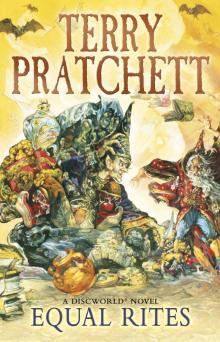 Equal Rites
Equal Rites A Hat Full of Sky
A Hat Full of Sky The Light Fantastic
The Light Fantastic Mrs Bradshaw's Handbook
Mrs Bradshaw's Handbook Wyrd Sisters
Wyrd Sisters Soul Music
Soul Music Small Gods
Small Gods Sourcery
Sourcery Reaper Man
Reaper Man Night Watch
Night Watch Lords and Ladies
Lords and Ladies The Fifth Elephant
The Fifth Elephant Monstrous Regiment
Monstrous Regiment The Truth
The Truth Witches Abroad
Witches Abroad Eric
Eric Going Postal
Going Postal Men at Arms
Men at Arms Jingo
Jingo The Amazing Maurice and His Educated Rodents
The Amazing Maurice and His Educated Rodents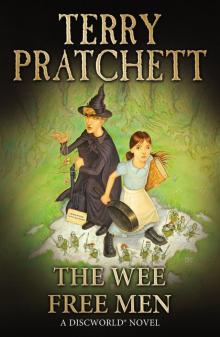 The Wee Free Men
The Wee Free Men Pyramids
Pyramids Wintersmith
Wintersmith Moving Pictures
Moving Pictures Carpe Jugulum
Carpe Jugulum Interesting Times
Interesting Times Maskerade
Maskerade Making Money
Making Money The Shepherd's Crown
The Shepherd's Crown Hogfather
Hogfather Troll Bridge
Troll Bridge The Last Continent
The Last Continent The Sea and Little Fishes
The Sea and Little Fishes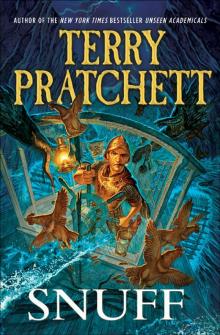 Snuff
Snuff Unseen Academicals
Unseen Academicals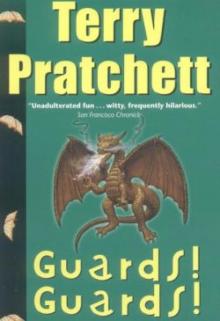 Guards! Guards! tds-8
Guards! Guards! tds-8 Jingo d-21
Jingo d-21 Turtle Recall: The Discworld Companion ... So Far
Turtle Recall: The Discworld Companion ... So Far The Fifth Elephant d-24
The Fifth Elephant d-24 Discworld 39 - Snuff
Discworld 39 - Snuff The Long War
The Long War Only You Can Save Mankind
Only You Can Save Mankind The Science of Discworld III - Darwin's Watch tsod-3
The Science of Discworld III - Darwin's Watch tsod-3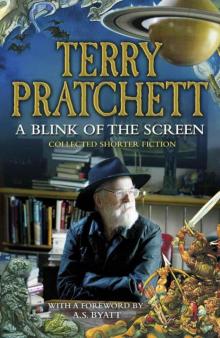 A Blink of the Screen: Collected Short Fiction
A Blink of the Screen: Collected Short Fiction Unseen Academicals d-37
Unseen Academicals d-37 Wings
Wings Making Money d-36
Making Money d-36 A Blink of the Screen
A Blink of the Screen Johnny and the Bomb
Johnny and the Bomb Dodger
Dodger Strata
Strata Discworld 02 - The Light Fantastic
Discworld 02 - The Light Fantastic The Folklore of Discworld
The Folklore of Discworld The Science of Discworld
The Science of Discworld The Unadulterated Cat
The Unadulterated Cat Raising Steam: (Discworld novel 40) (Discworld Novels)
Raising Steam: (Discworld novel 40) (Discworld Novels) The World of Poo
The World of Poo Discworld 05 - Sourcery
Discworld 05 - Sourcery The Witch's Vacuum Cleaner: And Other Stories
The Witch's Vacuum Cleaner: And Other Stories The Science of Discworld II - The Globe tsod-2
The Science of Discworld II - The Globe tsod-2 Small Gods: Discworld Novel, A
Small Gods: Discworld Novel, A Men at Arms tds-15
Men at Arms tds-15 Tama Princes of Mercury
Tama Princes of Mercury The Last Hero (the discworld series)
The Last Hero (the discworld series) The Long Utopia
The Long Utopia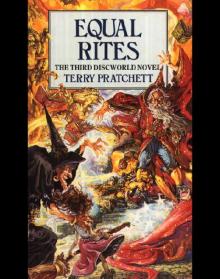 Discworld 03 - Equal Rites
Discworld 03 - Equal Rites Terry Pratchett - The Science of Discworld
Terry Pratchett - The Science of Discworld The Long Earth
The Long Earth The Carpet People
The Carpet People The Sea and Little Fishes (discworld)
The Sea and Little Fishes (discworld)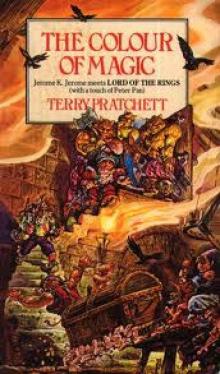 The Colour of Magic
The Colour of Magic Discworld 16 - Soul Music
Discworld 16 - Soul Music The Long Cosmos
The Long Cosmos The Dark Side of the Sun
The Dark Side of the Sun Monstrous Regiment tds-28
Monstrous Regiment tds-28 The Bromeliad 3 - Wings
The Bromeliad 3 - Wings Dragons at Crumbling Castle: And Other Stories
Dragons at Crumbling Castle: And Other Stories Night Watch tds-27
Night Watch tds-27 The Science of Discworld I tsod-1
The Science of Discworld I tsod-1 The Bromeliad 1 - Truckers
The Bromeliad 1 - Truckers The Science of Discworld Revised Edition
The Science of Discworld Revised Edition The Abominable Snowman
The Abominable Snowman Father Christmas’s Fake Beard
Father Christmas’s Fake Beard The Bromeliad Trilogy
The Bromeliad Trilogy A Slip of the Keyboard
A Slip of the Keyboard The Wee Free Men d(-2
The Wee Free Men d(-2 Johnny and the Dead
Johnny and the Dead Mrs Bradshaw's Handbook (Discworld Novels)
Mrs Bradshaw's Handbook (Discworld Novels) Truckers
Truckers The Amazing Maurice and His Educated Rodents d(-1
The Amazing Maurice and His Educated Rodents d(-1 Diggers
Diggers Thief of Time tds-26
Thief of Time tds-26 Science of Discworld III
Science of Discworld III Dragons at Crumbling Castle
Dragons at Crumbling Castle Nation
Nation Darwin's Watch
Darwin's Watch Interesting Times d-17
Interesting Times d-17 The Bromeliad 2 - Diggers
The Bromeliad 2 - Diggers The Science of Discworld II
The Science of Discworld II